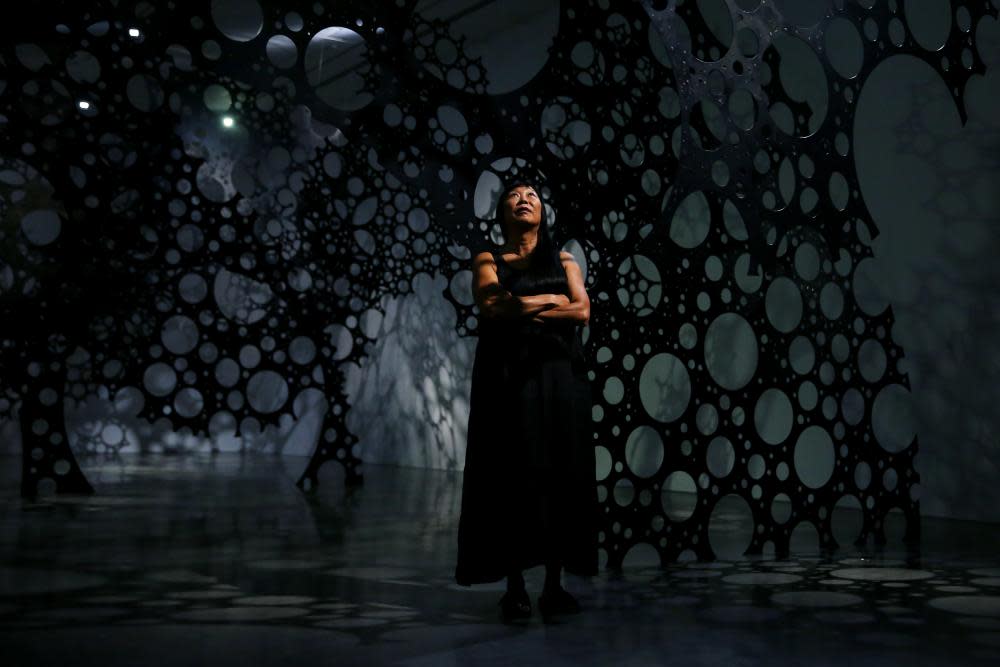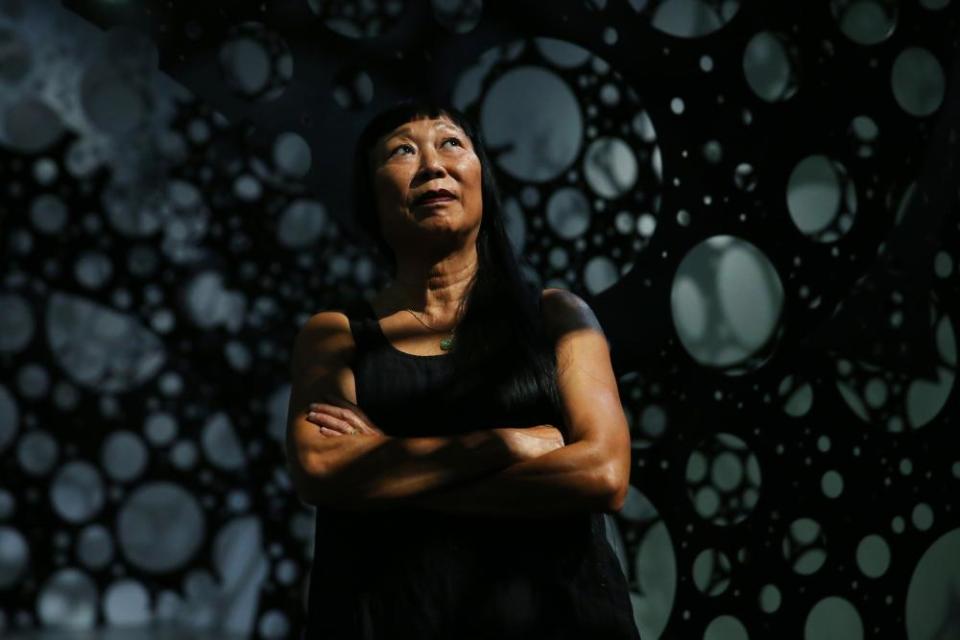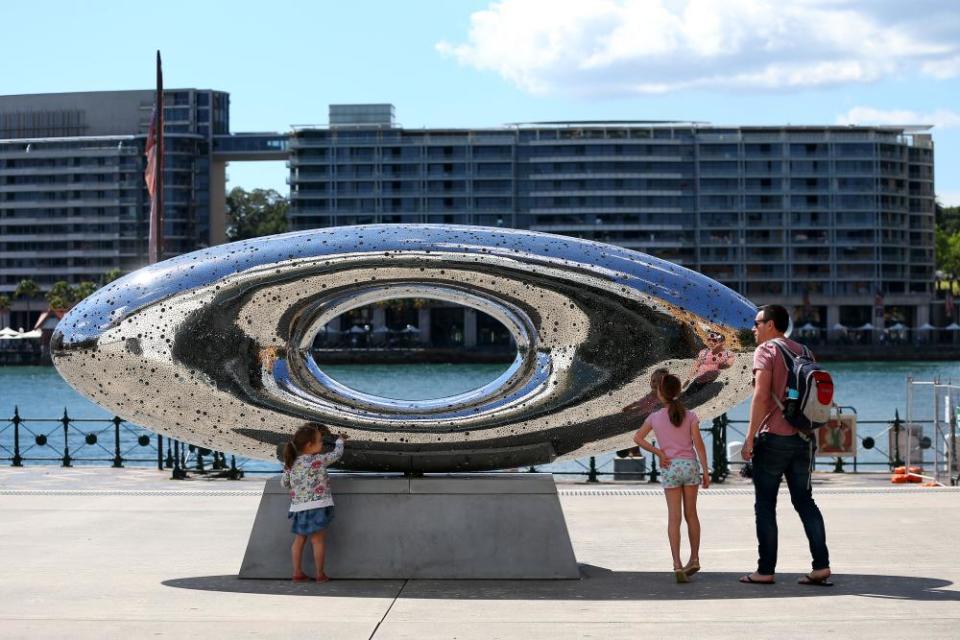Artist Lindy Lee: 'Anybody who has to declare they belong, doesn’t belong'

For decades, Brisbane-born artist Lindy Lee wanted to be anything other than Chinese.
Her late father, who had a backyard factory making cheap furniture, believed that once his family stepped outside their house they had to be “whiter than white”, the artist recalls. It was an attitude she internalised and which came to a head in 1988, Australia’s bicentennial year, when “everybody was considering Australian art and culture, what the hell that is”. Lee was asked to talk about her art on a panel at a Sydney College of the Arts conference.
“I’m doing these paintings because I’m declaring that I belong to the west,” she told the audience.
“Literally the moment that word bubble came out, I went, wait a minute,” says Lee now. “Anybody who has to declare that they belong, doesn’t belong.”
Related: Sydney's Sculpture by the Sea exhibition postponed due to Covid restrictions
Lee is now 66 and has a survey exhibition of her work, Moon in a Dew Drop, opening at the Museum of Contemporary Art Australia this week. She sits on the floor of the museum’s members’ lounge at Sydney’s Circular Quay during the exhibition installation, her legs folded like Buddha, in the shikantaza or “just sitting” style of the Zen meditation she has practiced for 25 years. It’s an impression of calm far removed from the inner turmoil she describes having gone through in her youth.
Lee paraphrases psychiatrist Carl Jung’s theory that questions repressed from consciousness will return as fate. “Everybody, not just [with] the race thing, will go through that,” she says. “The feeling of not belonging, of being cast aside, is a horrendous state for a human being.”
It wasn’t just her father’s ideas Lee internalised, but the “painful” prejudice against Asians she found in society from a young age – first as the only Chinese girl in her primary school, and then as one of only two in high school.

Given she was a girl, her education “didn’t really matter” to her parents – they expected Lee’s university education would be a mere precursor to getting married and having children; her conservative father even tried to arrange a Malaysian dentist as a potential husband, until her sister pulled their dad aside and said the match was never going to work.
The “silver lining” of this sexism, Lee said, was that during her studies, she could quietly become an artist.
In the late 1970s, Lee flew to London and studied at the Chelsea School of Art, followed by graduate school at the Sydney College of the Arts. She deliberately withheld from her parents that art was her field of study because, she says, they wouldn’t have understood.
“I just kept lying,” Lee says.
I cannot imagine what it’s like to think, I’m going to be an artist, and then be taken to a re-education camp
Lindy Lee
In her earliest works, Lee photocopied paintings by Flemish master Jan van Eyck over and over, intensely curious about the darker and denser layers the copier added. She made wax paintings, mixing up a black oil impasto, slathering her canvases with black beeswax paste, “reaching back, like an archaeology of some kind”.
Lee went to China, seeking to connect with Chinese artists. A Shanghai curator and writer bluntly set her straight: that connection would not be possible because she had not experienced Mao’s cultural revolution.
Lee decided the curator was correct. “I cannot imagine what it’s like to wake in the morning and think, I’m going to be an artist, and then be taken to a re-education camp, not to know what my life will be.”
Lee’s parents had experienced such suffering: both sides of her family were part of the landowning class targeted by the ruling communists, and both Lee’s grandmothers were imprisoned. Lee’s mother married her father by arrangement, and became a black-market trader at age 17, using gold coins to bribe prison guards to free her mother-in-law.
Lee eventually found her own “liberation” in the liminal spaces between western and Asian identities. Her genetics, ancestry and birthplace have given her “philosophical and cultural affinities” that make her curious about life, and spark her creative impulses, she says.

Buddhism and Daoism in particular have been central forces in her life and art since she was introduced to Zen meditation at a class in Sydney in 1995.
Her 2017 photographic work The Seamless Tomb is a “response to a koan”, a Zen Buddhism form of unsolvable riddle, and is a collaboration with her husband, Rob Scott-Mitchell, a photographer and skilled printer.
In The Seamless Tomb, Lee has reproduced a photograph showing her father and mother, their eldest son, and her father’s brother, taken circa 1946, just as her father is about to step on a boat in China for Australia.
“I can’t imagine how my mum felt,” says Lee. “She doesn’t talk about it. But she is the most intrepid woman, with a certain spirit. She will always find a way through life most meaningful for her.”
Related: Archibald prize 2020: Vincent Namatjira named winner for portrait of Adam Goodes
Although never written into the legislation, in practice under the White Australia Policy there was a one-for-one swap of non-white immigrant labour. Lee’s father was replacing her grandfather in Australia. It would be some time before a sympathetic immigration officer allowed her mother – then six months’ pregnant with her second child – to bring their two sons to live in Sydney.
Today, her mother’s sense of humour is intact even though she is in care with dementia, her memory failing, and she remains Lee’s “enduringly” biggest inspiration for her art.
And their relationship is strong. Lee remembers her mother responding to the news that her daughter was going to live with a boyfriend but not get married, affectionately mimicking her mother’s broken English: “Mum said, ‘I no understand you, but I love you, and you OK. I have to trust you.’
“And that is an exquisite gift.”
• Lindy Lee: Moon in a Dew Drop is showing at the Museum of Contemporary Art in Sydney until 26 April 2021

 Yahoo News
Yahoo News 
